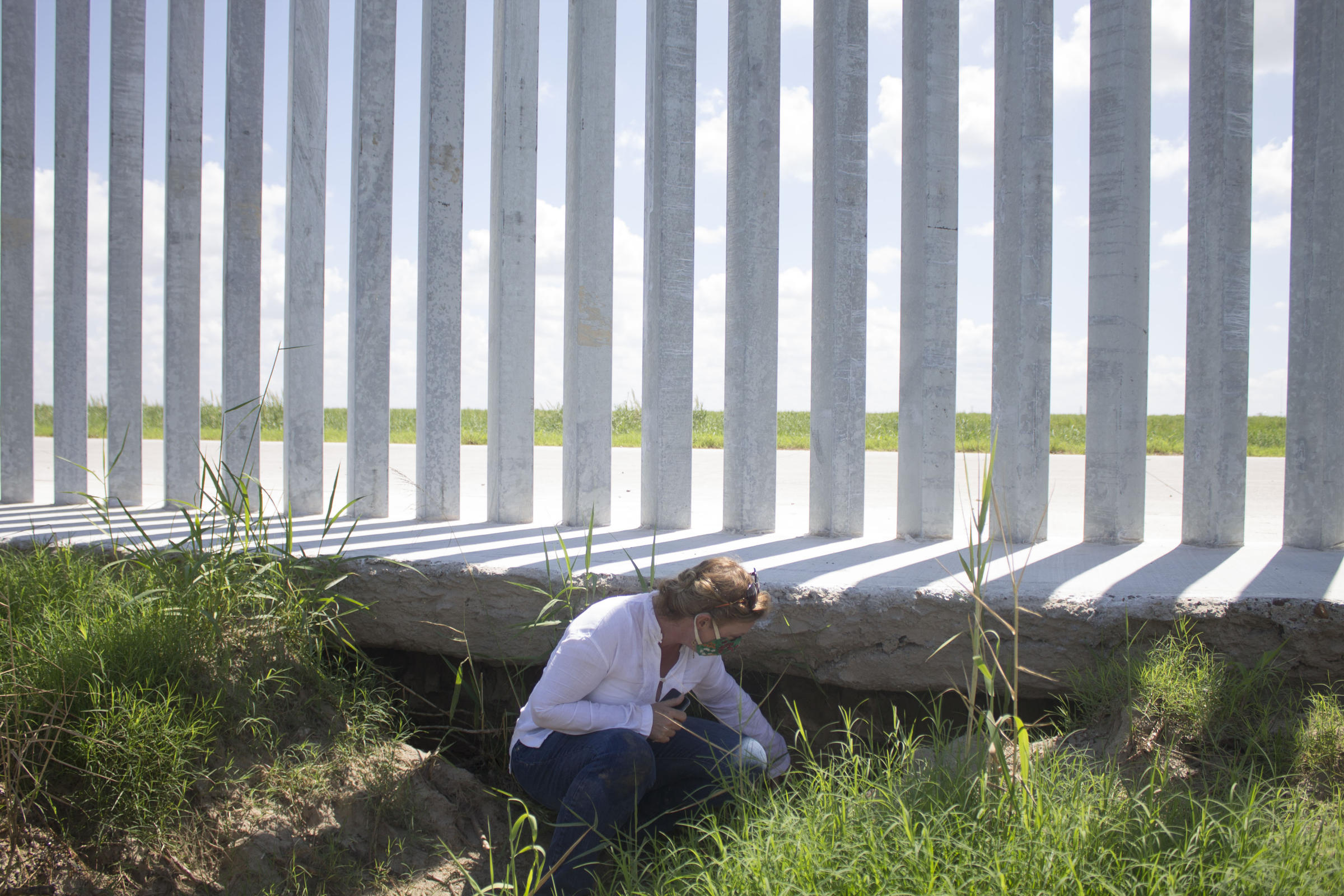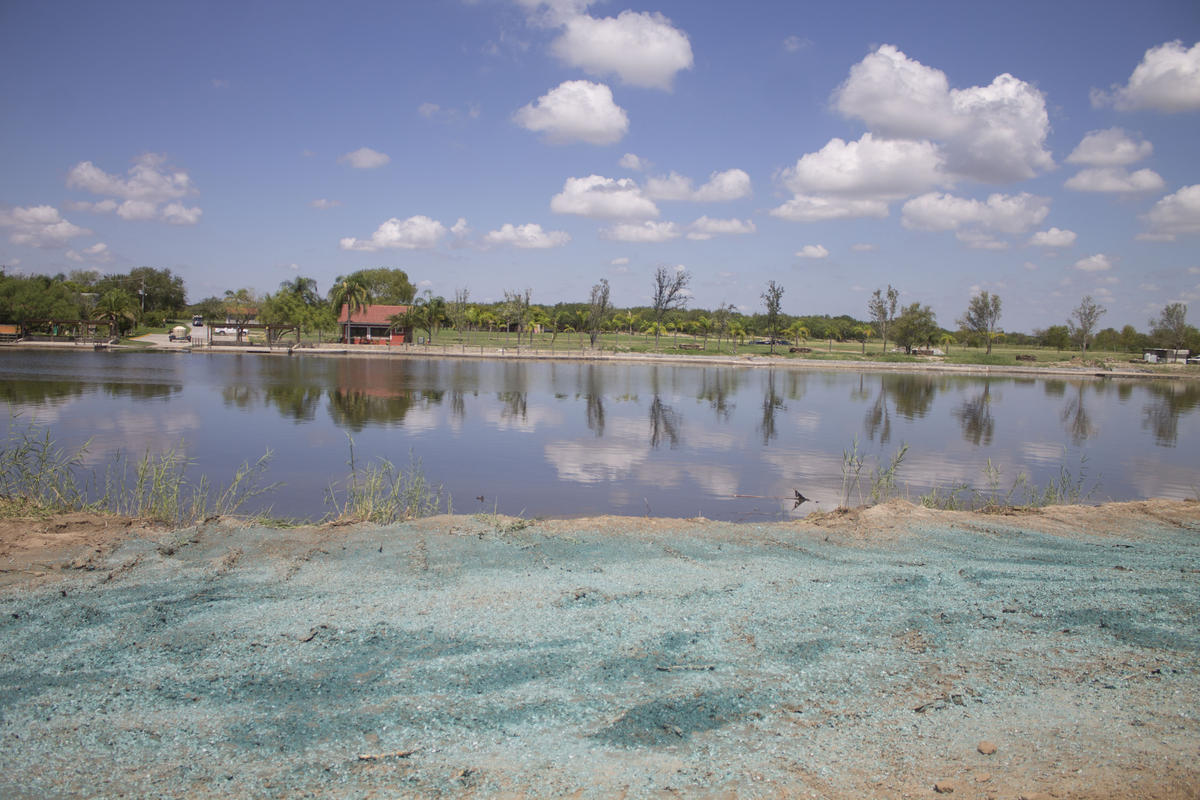Skip to comments.
Privately Built Border Wall In Texas Faces Erosion Worsened By Hurricane Hanna
Texas Public Radio ^
| 6 Aug 2020
| REYNALDO LEAÑOS JR.
Posted on 08/06/2020 8:24:22 PM PDT by BeauBo
Fisher is trying to repair the damage from Hurricane Hanna, the category one storm that hit The Valley two weeks ago.
Heavy machinery is picking-up dirt, dropping it off and smoothing it out on the south side of the wall, where he also plans on adding a road.
Fisher does not deny that his wall is having issues with erosion.
“No matter what we do, if there’s a huge storm there’s erosion. You guys can look anywhere you want in Hidalgo County and there’s been erosion that has happened,” said Fisher. “The difference here is that the erosion, or the storm, doesn’t affect the wall or the road and we have the ability to fix that here and we have the ability to make it stronger so it doesn’t happen, or it happens a lot less.”
He said they’re also doing something called hydroseeding, which adds vegetation to try and hold the soil together, and prevent future erosion
“On some places the grass grew more, some places it grew less, that’s why we’re coming back as part of our erosion control maintenance plan,” said Fisher.
Fisher’s wall is about 3 miles long and costs more than $40 million. He said he’s confident it will withstand future rainfall or an even stronger hurricane because it’s built to last.
“I guarantee that I’m going to be back here when I’m 90 and there’s nothing that’s going to have changed here,” said Fisher.
(Excerpt) Read more at tpr.org ...
TOPICS: Business/Economy; Foreign Affairs; Mexico; US: Texas
KEYWORDS: borderwall; fisher; immigration
Tommy Fisher is continuing to maintain and improve the private border wall that he built along the Rio Grande.
The grass seed did not take in big stretches along the river, and there was significant erosion in the freshly worked earth, when a hurricane dropped 16 inches of rain, overnight.
Not only is he already at work smoothing and re-seeding, he says that he will add a new road on the river side of the fence. That will add a huge amount of erosion resistance, and a lot of standoff distance from the wall itself.
Worst of the hurricane erosion (note that the foot thick slab on top is mainly to stabilize the structure from rocking in hurricane force winds - the bollards themselves are set in a much deeper reinforced concrete filled trench, a few feet back, under the overhang. The new road will extend that slab on the river side, like it is now on the other side:

At work

Smoothed and re-seeded (hydro-seeding).

1
posted on
08/06/2020 8:24:22 PM PDT
by
BeauBo
To: bakkentom; little jeremiah; thinden; SteveH; OldPossum; bert
Border Wall ping.
A new concrete road will be added along the River side, to mitigate future Hurricane erosion, and stand it off far from the base of the barrier.
Post hurricane erosion, in the area where the grass seed did not take. The area has already been regraded, and a heavy concrete road (a signature Fisher feature) is going to powerfully stabilize that soil in the future.

2
posted on
08/06/2020 8:47:09 PM PDT
by
BeauBo
To: BeauBo
I’ve had erosion in my backyard from the torrential rains (different tropical system).
3
posted on
08/06/2020 9:00:31 PM PDT
by
Lurkinanloomin
(Natural Born Citizens Are Born Here of Citizen Parents|Know Islam, No Peace-No Islam, Know Peace)
To: Lurkinanloomin
“I’ve had erosion in my backyard from the torrential rains”
I’m thinking that a foot thick slab of concrete will slow down erosion considerably...
I love how Fisher can throw such heavy resources at a problem like this.
4
posted on
08/06/2020 9:05:43 PM PDT
by
BeauBo
To: BeauBo
I don’t know what’s available locally, insofar as building materials go, but around where I live, we’d anchor landscape fabric, and place fractured rock, which locks into each other, but allows water to flow through easily. The rock should be sized to whatever size will withstand expected flood waters from that river. i.e. 2 foot minus, 12 inch minus, etc. Otherwise, it will be a routine maintenance issue. Grass is way cheaper, but in the long run, it’s probably more expensive.
A good engineer would be worth every penny. I could see the concrete road being underscoured, if the flood is big enough.
5
posted on
08/06/2020 10:22:10 PM PDT
by
krogers58
To: Lurkinanloomin
Then it’s no problem since he said:
“We have the ability to fix that here and we have the ability to make it stronger so it doesn’t happen, or it happens a lot less.”
6
posted on
08/06/2020 10:46:55 PM PDT
by
caww
To: BeauBo
looking like a giant fire ant nest lol
7
posted on
08/07/2020 12:15:30 AM PDT
by
SteveH
To: BeauBo
hydroseeding
this is basically a big water tank with a high pressure pump and hoses. The tank is filled with a mixture or water, seed, fertilizer, and a thickening agent, then the product is sprayed over large areas - often used in highway construction to cover roadsides by ramps.
This method also allows rapid reseeding with a faster growing grass that has a longer root structure to lessen erosion
8
posted on
08/07/2020 3:45:57 AM PDT
by
PIF
(They came for me and mine ... now its your turn)
To: krogers58
Some grasses have root structures that go down 6 feet or more
9
posted on
08/07/2020 3:48:54 AM PDT
by
PIF
(They came for me and mine ... now its your turn)
To: krogers58
“I could see the concrete road being underscoured, if the flood is big enough.”
“we’d anchor landscape fabric, and place fractured rock”
Tommy Fisher told the judge that he intended to place rip rap (rocks) where needed (where the grass won’t take). Apparently, the grass was growing along most of the (over three mile) run already, but the hurricane came early after the construction, while big spots were still bare, and before the soil had fully settled.
They graded the soil to a gentle slope, and sought to stabilize it with grass as an erosion control measure for an operational reason, as well as for cost. That smooth beach-like grade allows Border Patrol to run their river boats right up onto the banks, and jump out quickly.
If they designed it to be rocks everywhere, the design would impede Border Patrol deployments. Even out of the boats, having to routinely scramble over rough rocks (including in bad weather), chasing and fighting with people, would make for an unsafe environment for the Border Patrol Officers. Injuries would be predictable. That bank is designed to be their enforcement zone.
Although a concrete road could be underscoured (as we already saw a bit of, with this Cat 1 Hurricane), it is going to give quite a generous bit of stand off distance from the barrier itself. So it will provide much more protection to the barrier, even in a much bigger storm (even if there is still maintenance to do afterward). It is significant hardening/strengthening of the barrier, for the day that a storm strikes.
Also, the new road is going to cover a few feet of the elevation drop toward the river (the base of the barrier is designed to be eight feet above average water level), so there will be less of the bank exposed to the kind of surface runoff that eroded those gullies, before the rising river covers that elevation.
Maybe the President publicly chastised them on this project, specifically to pressure them into coughing up this money to strengthen it further.
10
posted on
08/07/2020 4:37:43 AM PDT
by
BeauBo
To: BeauBo
Tucson.com reporting heavy flooding on San Pedro River (AZ) has collapsed/filled trenches that had been dug for the Wall. This of course, can be remedied in several days.
11
posted on
08/07/2020 6:25:08 AM PDT
by
donozark
(We grow too soon old and too late smart.)
To: donozark
“Tucson.com reporting heavy flooding on San Pedro River (AZ) has collapsed/filled trenches that had been dug for the Wall. This of course, can be remedied in several days.”
The annual monsoon rains out there come like clockwork between the 4th of July and Labor Day. Every afternoon there is a thundershower to wash out the gullies, and every once in a while there will be a bigger one that will quickly flood low-lying areas of roads. Flash flooding is a normal effect there. They have a “Stupid Motorist” Law, that requires motorists to pay the expenses for being rescued, after they tried to drive through one of those, because it is so common that it irritates the locals.
So no surprise. They put in what they could before the rains came (Deep footings), and will likely pick up there next month. A good soaking will let the concrete cure good and hard in the meantime.
Weather happens to all construction, but those monsoons are more predictable than most.
12
posted on
08/07/2020 8:02:40 AM PDT
by
BeauBo
Disclaimer:
Opinions posted on Free Republic are those of the individual
posters and do not necessarily represent the opinion of Free Republic or its
management. All materials posted herein are protected by copyright law and the
exemption for fair use of copyrighted works.
FreeRepublic.com is powered by software copyright 2000-2008 John Robinson
